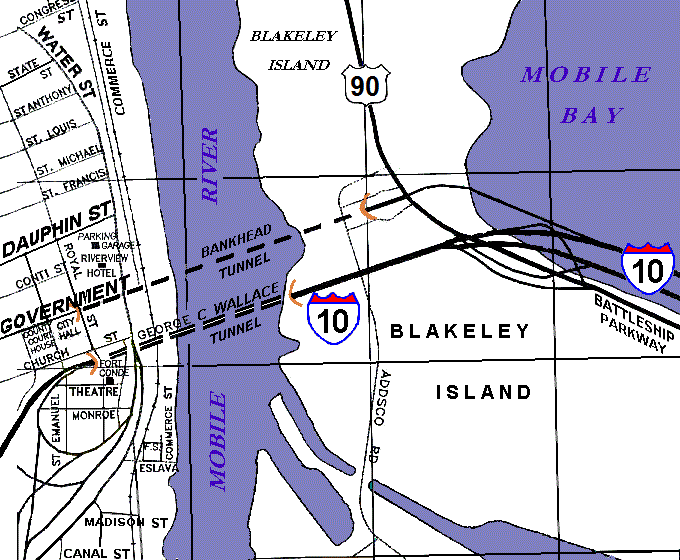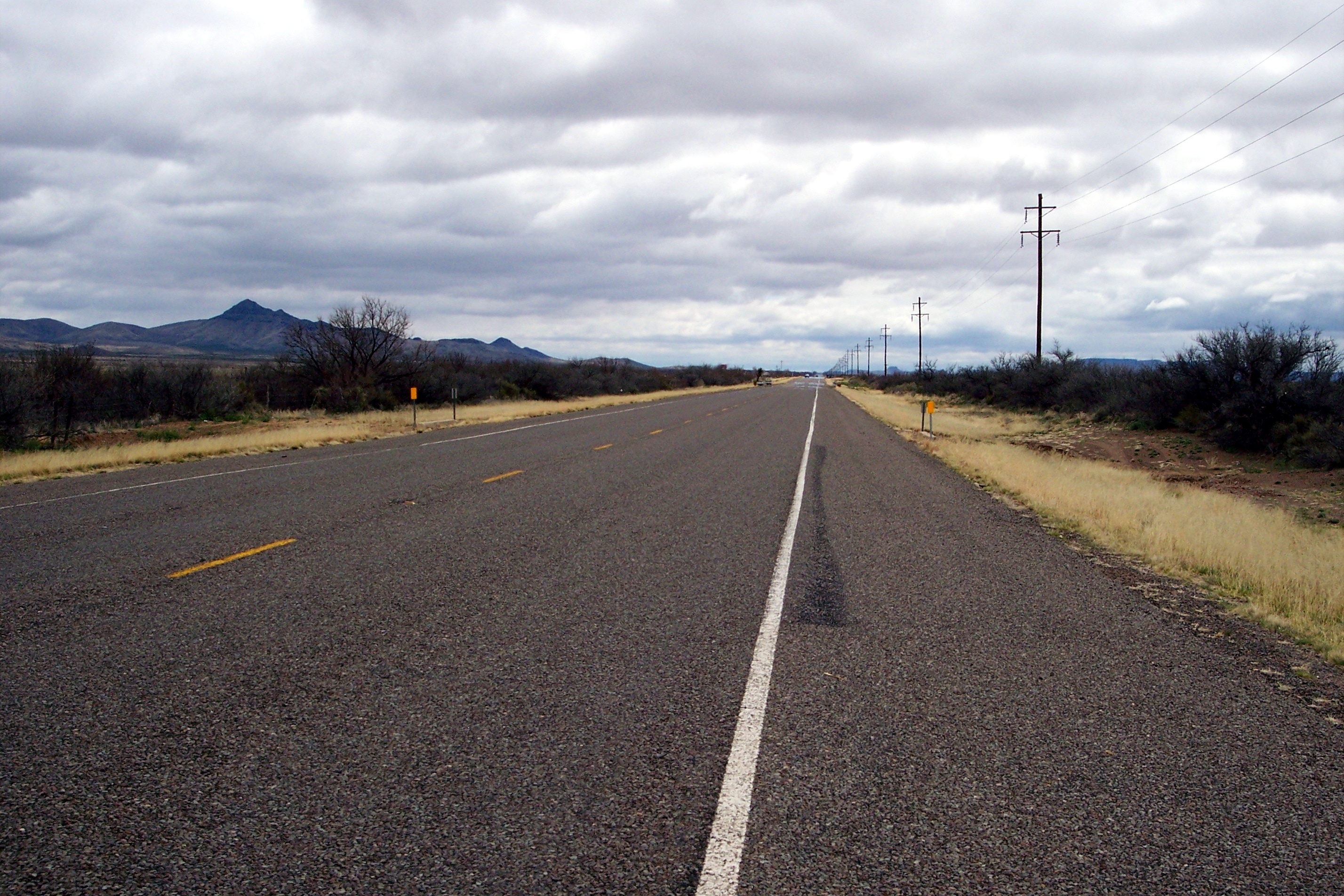|
Cochrane–Africatown USA Bridge
The Cochrane–Africatown USA Bridge is a cable-stayed bridge carrying US 90/ US 98 Truck across the Mobile River from the mainland to Blakeley Island in Mobile, Alabama. History The Cochrane–Africatown USA Bridge was completed and opened in 1991. It was named in honor of the 60-year-old vertical-lift Cochrane Bridge (in turn named for president of the Mobile, Alabama Chamber of Commerce at the time, John T. Cochrane, Sr.) that it replaced, and the historic community of Africatown, which was located where the western approach to the bridge was built. In 1997 community activists promoted preservation and designation of the Africatown Historic District to encourage development there. The district was included on Mobile's African American Heritage Trail in 2009. In 2012 it was added to the National Register of Historic Places. Volkert and Associates, Inc. design for the bridge earned it the Outstanding Engineering Achievement in the U.S.A. Award from the National S ... [...More Info...] [...Related Items...] OR: [Wikipedia] [Google] [Baidu] |
Mobile River
The Mobile River is located in southern Alabama in the United States. Formed out of the confluence of the Tombigbee and Alabama rivers, the approximately river drains an area of of Alabama, with a watershed extending into Mississippi, Georgia, and Tennessee. Its drainage basin is the fourth-largest of primary stream drainage basins entirely in the United States. The river has historically provided the principal navigational access for Alabama. Since construction of the Tennessee-Tombigbee Waterway, it also provides an alternative route into the Ohio River watershed. The Tombigbee and Alabama River join to form the Mobile River approximately northeast of Mobile, along the county line between Mobile and Baldwin counties. The combined stream flows south, in a winding course. Approximately downstream from the confluence, the channel of the river divides, with the Mobile flowing along the western channel. The Tensaw River, a bayou of the Mobile River, flows alongside to the e ... [...More Info...] [...Related Items...] OR: [Wikipedia] [Google] [Baidu] |
Drydock
A dry dock (sometimes drydock or dry-dock) is a narrow basin or vessel that can be flooded to allow a load to be floated in, then drained to allow that load to come to rest on a dry platform. Dry docks are used for the construction, maintenance, and repair of ships, boats, and other watercraft. History Greco-Roman world The Greek author Athenaeus of Naucratis (V 204c-d) reports something that may have been a dry dock in Ptolemaic Egypt in the reign of Ptolemy IV Philopator (221-204 BC) on the occasion of the launch of the enormous '' Tessarakonteres'' rowing ship. It has been calculated that a dock for a vessel of such a size might have had a volume of 750,000 gallons of water. In Roman times, a shipyard at Narni, which is still studied, may have served as a dry dock. Medieval China The use of dry docks in China goes at least as far back the 10th century A.D. In 1088, Song Dynasty scientist and statesman Shen Kuo (1031–1095) wrote in his '' Dream Pool Essays'': Re ... [...More Info...] [...Related Items...] OR: [Wikipedia] [Google] [Baidu] |
Road Bridges In Alabama
A road is a linear way for the conveyance of traffic that mostly has an improved surface for use by vehicles (motorized and non-motorized) and pedestrians. Unlike streets, the main function of roads is transportation. There are many types of roads, including parkways, avenues, controlled-access highways (freeways, motorways, and expressways), tollways, interstates, highways, thoroughfares, and local roads. The primary features of roads include lanes, sidewalks (pavement), roadways (carriageways), medians, shoulders, verges, bike paths (cycle paths), and shared-use paths. Definitions Historically many roads were simply recognizable routes without any formal construction or some maintenance. The Organization for Economic Co-operation and Development (OECD) defines a road as "a line of communication (travelled way) using a stabilized base other than rails or air strips open to public traffic, primarily for the use of road motor vehicles running on their own wheels", whic ... [...More Info...] [...Related Items...] OR: [Wikipedia] [Google] [Baidu] |
Bridges Over The Mobile River
A bridge is a structure built to span a physical obstacle (such as a body of water, valley, road, or rail) without blocking the way underneath. It is constructed for the purpose of providing passage over the obstacle, which is usually something that is otherwise difficult or impossible to cross. There are many different designs of bridges, each serving a particular purpose and applicable to different situations. Designs of bridges vary depending on factors such as the function of the bridge, the nature of the terrain where the bridge is constructed and anchored, and the material used to make it, and the funds available to build it. The earliest bridges were likely made with fallen trees and stepping stones. The Neolithic people built boardwalk bridges across marshland. The Arkadiko Bridge (dating from the 13th century BC, in the Peloponnese) is one of the oldest arch bridges still in existence and use. Etymology The ''Oxford English Dictionary'' traces the origin of the wo ... [...More Info...] [...Related Items...] OR: [Wikipedia] [Google] [Baidu] |
Cable-stayed Bridges In The United States
A cable-stayed bridge has one or more ''towers'' (or ''pylons''), from which cables support the bridge deck. A distinctive feature are the cables or stays, which run directly from the tower to the deck, normally forming a fan-like pattern or a series of parallel lines. This is in contrast to the modern suspension bridge, where the cables supporting the deck are suspended vertically from the main cable, anchored at both ends of the bridge and running between the towers. The cable-stayed bridge is optimal for spans longer than cantilever bridges and shorter than suspension bridges. This is the range within which cantilever bridges would rapidly grow heavier, and suspension bridge cabling would be more costly. Cable-stayed bridges were being designed and constructed by the late 16th century, and the form found wide use in the late 19th century. Early examples, including the Brooklyn Bridge, often combined features from both the cable-stayed and suspension designs. Cable-staye ... [...More Info...] [...Related Items...] OR: [Wikipedia] [Google] [Baidu] |
Bankhead Tunnel
The Bankhead Tunnel, formally the John H. Bankhead Tunnel, is a road tunnel in Mobile, Alabama that carries Government Street under the Mobile River from Blakeley Island to the downtown Mobile business district. "Mobile City Guide" (map, landmarks), AARoads, February 2011, webpage: SER-Bankhead "Frequently Asked Questions - Mobile Area Chamber of Commerce" (notes), Mobile Area Chamber of Commerce, 2006, webpage: MCCOM-FAQ. It is named for John H. Bankhead, an Alabama politician and U.S. Senator (served 1907-1920) who was also the grandfather of actress Tallulah Bankhead. It, like the larger George Wallace Tunnel (built 1969-1973) a few blocks downriver from it, was constructed in Mobile at the shipyards of the Alabama Drydock and Shipbuilding Company (ADDSCO), from 1938-1940. The eastern end of the Bankhead Tunnel features a large "flood door" that can be closed to prevent water from Mobile Bay flooding the tunnel during surges from hurricanes or tropical stor ... [...More Info...] [...Related Items...] OR: [Wikipedia] [Google] [Baidu] |
US 98
U.S. Route 98 (US 98) is an east–west United States Highway in the Southeastern United States that runs from western Mississippi to southern Florida. It was established in 1933 as a route between Pensacola and Apalachicola, Florida, and has since been extended westward into Mississippi and eastward across the Florida Peninsula. It runs along much of the Gulf Coast between Mobile, Alabama, and Crystal River, Florida, including extensive sections closely following the coast between Mobile and St. Marks, Florida. The highway's western terminus is with US 84 in Natchez, Mississippi. Its eastern terminus is Palm Beach, Florida, at State Road A1A (SR A1A) near the Mar-a-Lago resort. Route description U.S. 98's western terminus is in Mississippi, and its eastern terminus is in Florida. Much of its route through Alabama and Florida falls within coastal counties. Mississippi U.S. 98 enters the state from the southeast and immediately widens to four lanes. It bypasse ... [...More Info...] [...Related Items...] OR: [Wikipedia] [Google] [Baidu] |
US 90
U.S. Route 90 or U.S. Highway 90 (US 90) is an east–west major United States highway in the Southern United States. Despite the "0" in its route number, US 90 never was a full coast-to-coast route. With the exception of a short-lived northward extension to US 62/ US 180 near Pine Springs, Texas that existed for less than one year, its western terminus has always been at Van Horn, Texas; this is an intersection with Interstate 10 Business (formerly US 80) just north of an interchange with Interstate 10. Its eastern terminus is at Florida State Road A1A in Jacksonville Beach, Florida, three blocks from the Atlantic Ocean. On August 29, 2005, a number of the highway's bridges in Mississippi and Louisiana were destroyed or damaged due to Hurricane Katrina, including the Bay St. Louis Bridge, the Biloxi Bay Bridge, and the Fort Pike Bridge. US 90 has seven exits on I-10 in the State of Florida. It also includes part of the DeSoto Trail between T ... [...More Info...] [...Related Items...] OR: [Wikipedia] [Google] [Baidu] |
Truck Plate
A truck or lorry is a motor vehicle designed to transport cargo, carry specialized payloads, or perform other utilitarian work. Trucks vary greatly in size, power, and configuration, but the vast majority feature body-on-frame construction, with a cabin that is independent of the payload portion of the vehicle. Smaller varieties may be mechanically similar to some automobiles. Commercial trucks can be very large and powerful and may be configured to be mounted with specialized equipment, such as in the case of refuse trucks, fire trucks, concrete mixers, and suction excavators. In American English, a commercial vehicle without a trailer or other articulation is formally a "straight truck" while one designed specifically to pull a trailer is not a truck but a "tractor". The majority of trucks currently in use are still powered by diesel engines, although small- to medium-size trucks with gasoline engines exist in the US, Canada, and Mexico. The market-share of electrically ... [...More Info...] [...Related Items...] OR: [Wikipedia] [Google] [Baidu] |
No Image Wide
No (and variant writings) may refer to one of these articles: English language * ''Yes'' and ''no'' (responses) * A determiner in noun phrases Alphanumeric symbols * No (kana), a letter/syllable in Japanese script * No symbol, displayed 🚫 * Numero sign, a typographic symbol for the word 'number', also represented as "No." or similar variants Geography * Norway (ISO 3166-1 country code NO) ** Norwegian language (ISO 639-1 code "no"), a North Germanic language that is also the official language of Norway ** .no, the internet ccTLD for Norway * Lake No, in South Sudan * No, Denmark, village in Denmark * Nō, Niigata, a former town in Japan * No Creek (other) * Acronym for the U.S. city of New Orleans, Louisiana or its professional sports teams ** New Orleans Saints of the National Football League ** New Orleans Pelicans of the National Basketball Association Arts and entertainment Film and television * ''Dr. No'' (film), a 1962 ''James Bond'' film ** Julius N ... [...More Info...] [...Related Items...] OR: [Wikipedia] [Google] [Baidu] |
_-_dry_dock_Pearl_Harbor_(1).jpg)



.jpg)

.jpg)